Australia's Plastic Waste: An Environmental Economics Appraisal Report
VerifiedAdded on 2023/03/21
|10
|3493
|69
Report
AI Summary
This report provides an environmental economics appraisal of plastic waste management in Australia. It begins by outlining the global environmental challenges, including climate change and the impact of plastic pollution on ecosystems and human health. The report highlights the increasing plastic usage in Australia, its effects on marine life, and the role of affordability and durability in driving consumption. It examines the actions taken by the Australian government, including environmental laws and policies like the Clean Water Act and the Paris Agreement, while also addressing the conflict between these regulations and the population's continued reliance on plastic. The report explores the concept of eco-system services and the vulnerability of the Australian environment, emphasizing the need for sustainable development and evidence-based management. It then discusses various strategies for managing plastic waste, such as the 'Reuse, Recycle and Reduce' policy, and the challenges associated with light-weight plastics. The report aims to provide a comprehensive overview of the plastic waste problem in Australia and potential policy solutions.
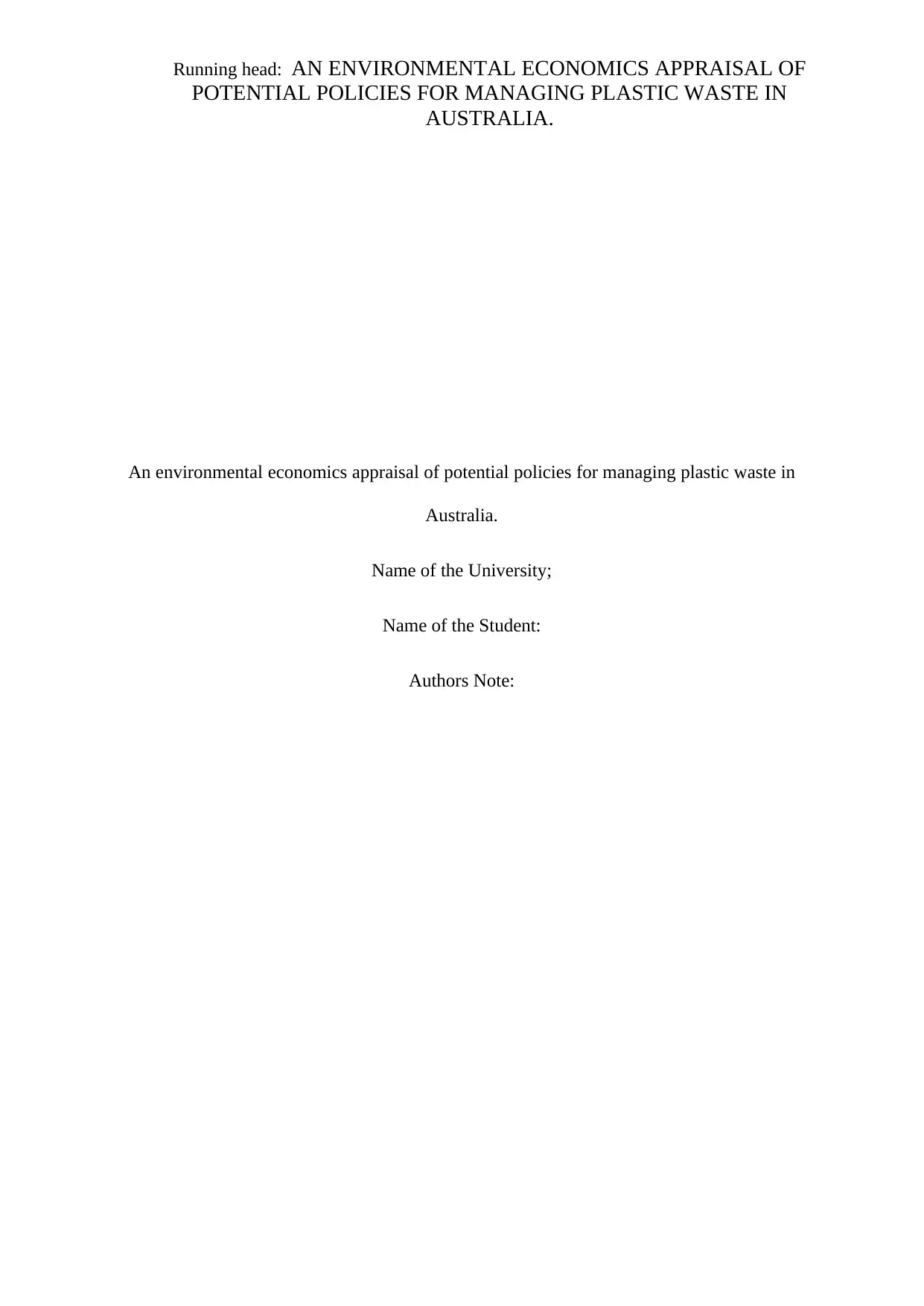
Running head: AN ENVIRONMENTAL ECONOMICS APPRAISAL OF
POTENTIAL POLICIES FOR MANAGING PLASTIC WASTE IN
AUSTRALIA.
An environmental economics appraisal of potential policies for managing plastic waste in
Australia.
Name of the University;
Name of the Student:
Authors Note:
POTENTIAL POLICIES FOR MANAGING PLASTIC WASTE IN
AUSTRALIA.
An environmental economics appraisal of potential policies for managing plastic waste in
Australia.
Name of the University;
Name of the Student:
Authors Note:
Paraphrase This Document
Need a fresh take? Get an instant paraphrase of this document with our AI Paraphraser
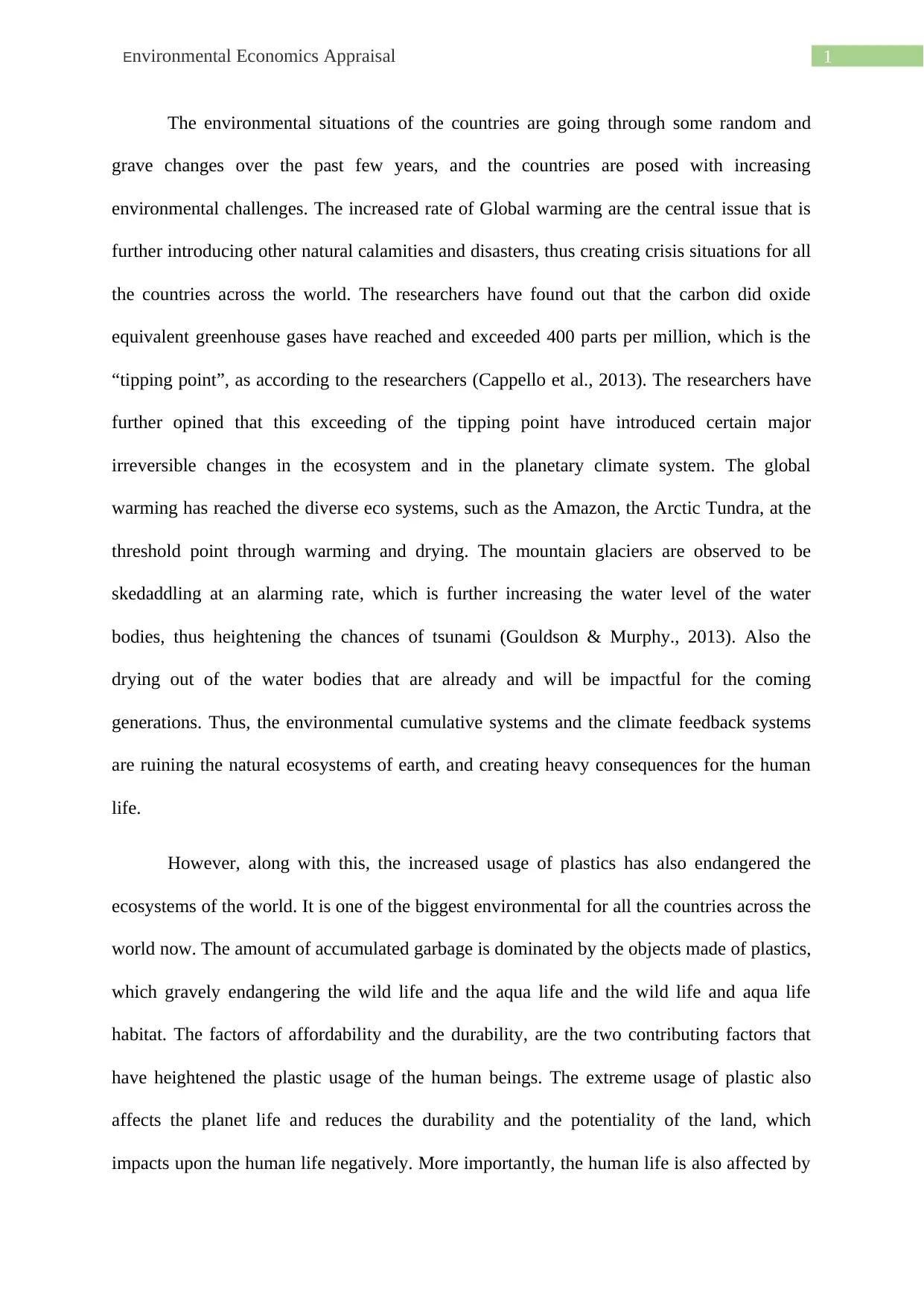
1Environmental Economics Appraisal
The environmental situations of the countries are going through some random and
grave changes over the past few years, and the countries are posed with increasing
environmental challenges. The increased rate of Global warming are the central issue that is
further introducing other natural calamities and disasters, thus creating crisis situations for all
the countries across the world. The researchers have found out that the carbon did oxide
equivalent greenhouse gases have reached and exceeded 400 parts per million, which is the
“tipping point”, as according to the researchers (Cappello et al., 2013). The researchers have
further opined that this exceeding of the tipping point have introduced certain major
irreversible changes in the ecosystem and in the planetary climate system. The global
warming has reached the diverse eco systems, such as the Amazon, the Arctic Tundra, at the
threshold point through warming and drying. The mountain glaciers are observed to be
skedaddling at an alarming rate, which is further increasing the water level of the water
bodies, thus heightening the chances of tsunami (Gouldson & Murphy., 2013). Also the
drying out of the water bodies that are already and will be impactful for the coming
generations. Thus, the environmental cumulative systems and the climate feedback systems
are ruining the natural ecosystems of earth, and creating heavy consequences for the human
life.
However, along with this, the increased usage of plastics has also endangered the
ecosystems of the world. It is one of the biggest environmental for all the countries across the
world now. The amount of accumulated garbage is dominated by the objects made of plastics,
which gravely endangering the wild life and the aqua life and the wild life and aqua life
habitat. The factors of affordability and the durability, are the two contributing factors that
have heightened the plastic usage of the human beings. The extreme usage of plastic also
affects the planet life and reduces the durability and the potentiality of the land, which
impacts upon the human life negatively. More importantly, the human life is also affected by
The environmental situations of the countries are going through some random and
grave changes over the past few years, and the countries are posed with increasing
environmental challenges. The increased rate of Global warming are the central issue that is
further introducing other natural calamities and disasters, thus creating crisis situations for all
the countries across the world. The researchers have found out that the carbon did oxide
equivalent greenhouse gases have reached and exceeded 400 parts per million, which is the
“tipping point”, as according to the researchers (Cappello et al., 2013). The researchers have
further opined that this exceeding of the tipping point have introduced certain major
irreversible changes in the ecosystem and in the planetary climate system. The global
warming has reached the diverse eco systems, such as the Amazon, the Arctic Tundra, at the
threshold point through warming and drying. The mountain glaciers are observed to be
skedaddling at an alarming rate, which is further increasing the water level of the water
bodies, thus heightening the chances of tsunami (Gouldson & Murphy., 2013). Also the
drying out of the water bodies that are already and will be impactful for the coming
generations. Thus, the environmental cumulative systems and the climate feedback systems
are ruining the natural ecosystems of earth, and creating heavy consequences for the human
life.
However, along with this, the increased usage of plastics has also endangered the
ecosystems of the world. It is one of the biggest environmental for all the countries across the
world now. The amount of accumulated garbage is dominated by the objects made of plastics,
which gravely endangering the wild life and the aqua life and the wild life and aqua life
habitat. The factors of affordability and the durability, are the two contributing factors that
have heightened the plastic usage of the human beings. The extreme usage of plastic also
affects the planet life and reduces the durability and the potentiality of the land, which
impacts upon the human life negatively. More importantly, the human life is also affected by
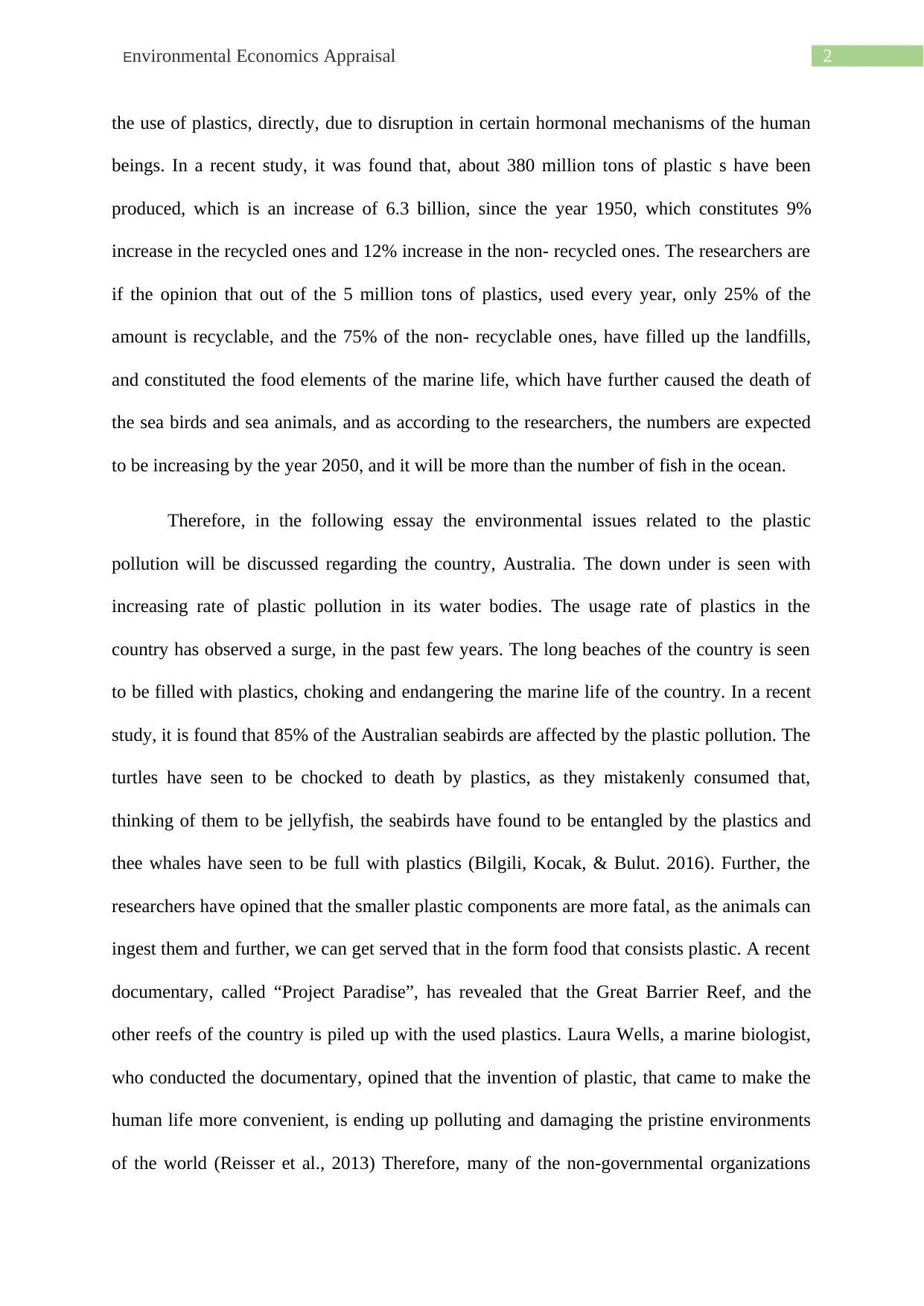
2Environmental Economics Appraisal
the use of plastics, directly, due to disruption in certain hormonal mechanisms of the human
beings. In a recent study, it was found that, about 380 million tons of plastic s have been
produced, which is an increase of 6.3 billion, since the year 1950, which constitutes 9%
increase in the recycled ones and 12% increase in the non- recycled ones. The researchers are
if the opinion that out of the 5 million tons of plastics, used every year, only 25% of the
amount is recyclable, and the 75% of the non- recyclable ones, have filled up the landfills,
and constituted the food elements of the marine life, which have further caused the death of
the sea birds and sea animals, and as according to the researchers, the numbers are expected
to be increasing by the year 2050, and it will be more than the number of fish in the ocean.
Therefore, in the following essay the environmental issues related to the plastic
pollution will be discussed regarding the country, Australia. The down under is seen with
increasing rate of plastic pollution in its water bodies. The usage rate of plastics in the
country has observed a surge, in the past few years. The long beaches of the country is seen
to be filled with plastics, choking and endangering the marine life of the country. In a recent
study, it is found that 85% of the Australian seabirds are affected by the plastic pollution. The
turtles have seen to be chocked to death by plastics, as they mistakenly consumed that,
thinking of them to be jellyfish, the seabirds have found to be entangled by the plastics and
thee whales have seen to be full with plastics (Bilgili, Kocak, & Bulut. 2016). Further, the
researchers have opined that the smaller plastic components are more fatal, as the animals can
ingest them and further, we can get served that in the form food that consists plastic. A recent
documentary, called “Project Paradise”, has revealed that the Great Barrier Reef, and the
other reefs of the country is piled up with the used plastics. Laura Wells, a marine biologist,
who conducted the documentary, opined that the invention of plastic, that came to make the
human life more convenient, is ending up polluting and damaging the pristine environments
of the world (Reisser et al., 2013) Therefore, many of the non-governmental organizations
the use of plastics, directly, due to disruption in certain hormonal mechanisms of the human
beings. In a recent study, it was found that, about 380 million tons of plastic s have been
produced, which is an increase of 6.3 billion, since the year 1950, which constitutes 9%
increase in the recycled ones and 12% increase in the non- recycled ones. The researchers are
if the opinion that out of the 5 million tons of plastics, used every year, only 25% of the
amount is recyclable, and the 75% of the non- recyclable ones, have filled up the landfills,
and constituted the food elements of the marine life, which have further caused the death of
the sea birds and sea animals, and as according to the researchers, the numbers are expected
to be increasing by the year 2050, and it will be more than the number of fish in the ocean.
Therefore, in the following essay the environmental issues related to the plastic
pollution will be discussed regarding the country, Australia. The down under is seen with
increasing rate of plastic pollution in its water bodies. The usage rate of plastics in the
country has observed a surge, in the past few years. The long beaches of the country is seen
to be filled with plastics, choking and endangering the marine life of the country. In a recent
study, it is found that 85% of the Australian seabirds are affected by the plastic pollution. The
turtles have seen to be chocked to death by plastics, as they mistakenly consumed that,
thinking of them to be jellyfish, the seabirds have found to be entangled by the plastics and
thee whales have seen to be full with plastics (Bilgili, Kocak, & Bulut. 2016). Further, the
researchers have opined that the smaller plastic components are more fatal, as the animals can
ingest them and further, we can get served that in the form food that consists plastic. A recent
documentary, called “Project Paradise”, has revealed that the Great Barrier Reef, and the
other reefs of the country is piled up with the used plastics. Laura Wells, a marine biologist,
who conducted the documentary, opined that the invention of plastic, that came to make the
human life more convenient, is ending up polluting and damaging the pristine environments
of the world (Reisser et al., 2013) Therefore, many of the non-governmental organizations
⊘ This is a preview!⊘
Do you want full access?
Subscribe today to unlock all pages.

Trusted by 1+ million students worldwide
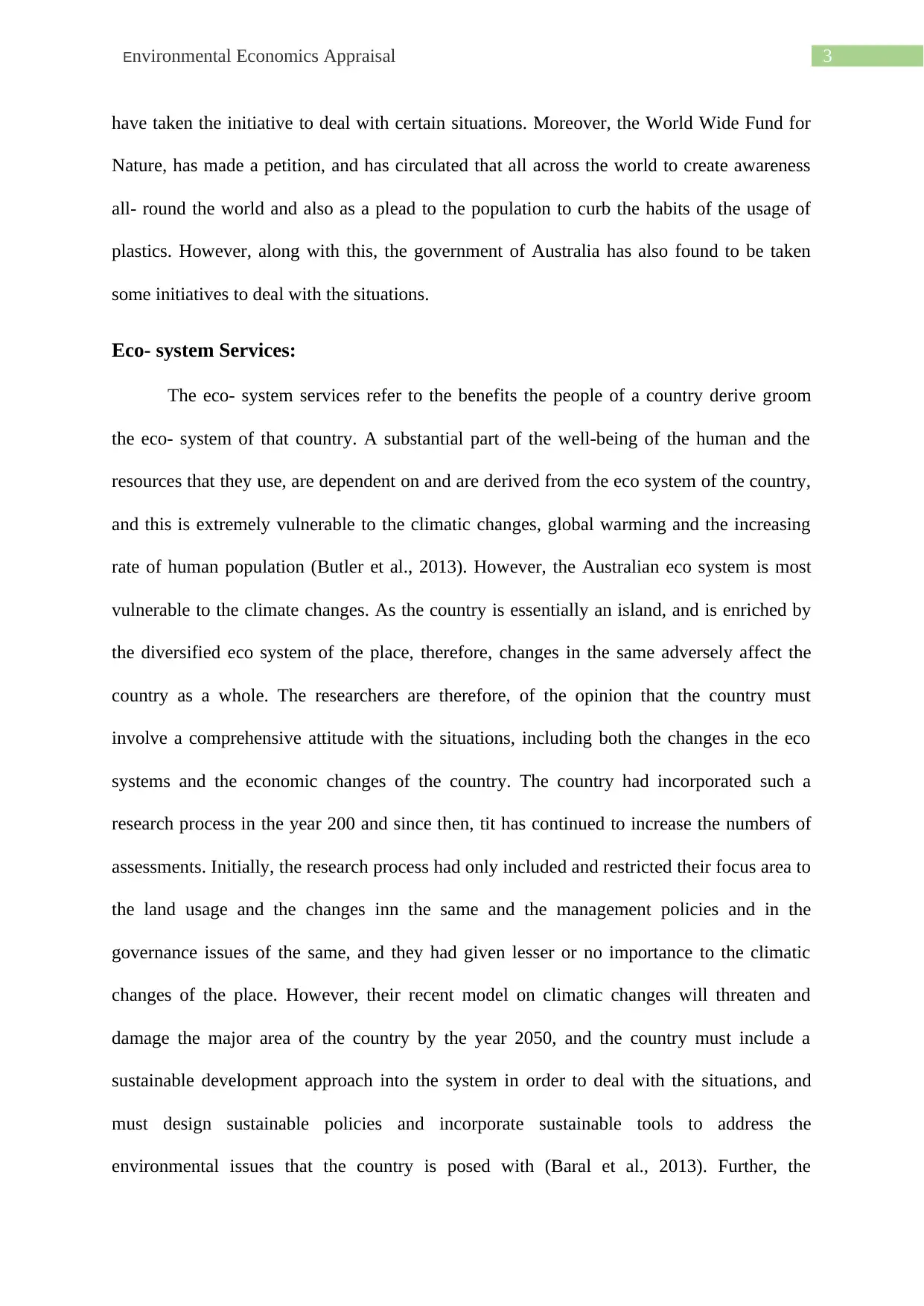
3Environmental Economics Appraisal
have taken the initiative to deal with certain situations. Moreover, the World Wide Fund for
Nature, has made a petition, and has circulated that all across the world to create awareness
all- round the world and also as a plead to the population to curb the habits of the usage of
plastics. However, along with this, the government of Australia has also found to be taken
some initiatives to deal with the situations.
Eco- system Services:
The eco- system services refer to the benefits the people of a country derive groom
the eco- system of that country. A substantial part of the well-being of the human and the
resources that they use, are dependent on and are derived from the eco system of the country,
and this is extremely vulnerable to the climatic changes, global warming and the increasing
rate of human population (Butler et al., 2013). However, the Australian eco system is most
vulnerable to the climate changes. As the country is essentially an island, and is enriched by
the diversified eco system of the place, therefore, changes in the same adversely affect the
country as a whole. The researchers are therefore, of the opinion that the country must
involve a comprehensive attitude with the situations, including both the changes in the eco
systems and the economic changes of the country. The country had incorporated such a
research process in the year 200 and since then, tit has continued to increase the numbers of
assessments. Initially, the research process had only included and restricted their focus area to
the land usage and the changes inn the same and the management policies and in the
governance issues of the same, and they had given lesser or no importance to the climatic
changes of the place. However, their recent model on climatic changes will threaten and
damage the major area of the country by the year 2050, and the country must include a
sustainable development approach into the system in order to deal with the situations, and
must design sustainable policies and incorporate sustainable tools to address the
environmental issues that the country is posed with (Baral et al., 2013). Further, the
have taken the initiative to deal with certain situations. Moreover, the World Wide Fund for
Nature, has made a petition, and has circulated that all across the world to create awareness
all- round the world and also as a plead to the population to curb the habits of the usage of
plastics. However, along with this, the government of Australia has also found to be taken
some initiatives to deal with the situations.
Eco- system Services:
The eco- system services refer to the benefits the people of a country derive groom
the eco- system of that country. A substantial part of the well-being of the human and the
resources that they use, are dependent on and are derived from the eco system of the country,
and this is extremely vulnerable to the climatic changes, global warming and the increasing
rate of human population (Butler et al., 2013). However, the Australian eco system is most
vulnerable to the climate changes. As the country is essentially an island, and is enriched by
the diversified eco system of the place, therefore, changes in the same adversely affect the
country as a whole. The researchers are therefore, of the opinion that the country must
involve a comprehensive attitude with the situations, including both the changes in the eco
systems and the economic changes of the country. The country had incorporated such a
research process in the year 200 and since then, tit has continued to increase the numbers of
assessments. Initially, the research process had only included and restricted their focus area to
the land usage and the changes inn the same and the management policies and in the
governance issues of the same, and they had given lesser or no importance to the climatic
changes of the place. However, their recent model on climatic changes will threaten and
damage the major area of the country by the year 2050, and the country must include a
sustainable development approach into the system in order to deal with the situations, and
must design sustainable policies and incorporate sustainable tools to address the
environmental issues that the country is posed with (Baral et al., 2013). Further, the
Paraphrase This Document
Need a fresh take? Get an instant paraphrase of this document with our AI Paraphraser
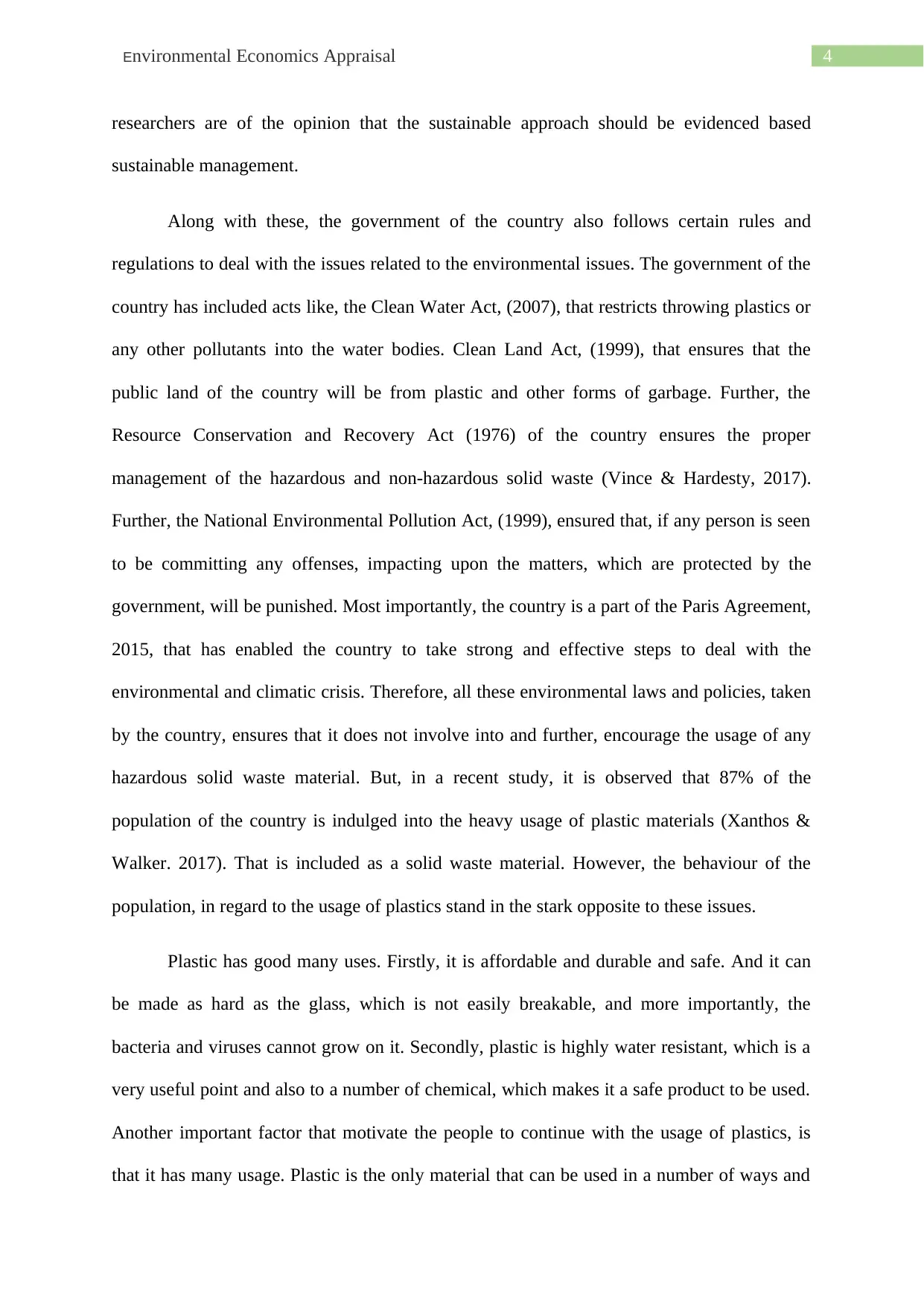
4Environmental Economics Appraisal
researchers are of the opinion that the sustainable approach should be evidenced based
sustainable management.
Along with these, the government of the country also follows certain rules and
regulations to deal with the issues related to the environmental issues. The government of the
country has included acts like, the Clean Water Act, (2007), that restricts throwing plastics or
any other pollutants into the water bodies. Clean Land Act, (1999), that ensures that the
public land of the country will be from plastic and other forms of garbage. Further, the
Resource Conservation and Recovery Act (1976) of the country ensures the proper
management of the hazardous and non-hazardous solid waste (Vince & Hardesty, 2017).
Further, the National Environmental Pollution Act, (1999), ensured that, if any person is seen
to be committing any offenses, impacting upon the matters, which are protected by the
government, will be punished. Most importantly, the country is a part of the Paris Agreement,
2015, that has enabled the country to take strong and effective steps to deal with the
environmental and climatic crisis. Therefore, all these environmental laws and policies, taken
by the country, ensures that it does not involve into and further, encourage the usage of any
hazardous solid waste material. But, in a recent study, it is observed that 87% of the
population of the country is indulged into the heavy usage of plastic materials (Xanthos &
Walker. 2017). That is included as a solid waste material. However, the behaviour of the
population, in regard to the usage of plastics stand in the stark opposite to these issues.
Plastic has good many uses. Firstly, it is affordable and durable and safe. And it can
be made as hard as the glass, which is not easily breakable, and more importantly, the
bacteria and viruses cannot grow on it. Secondly, plastic is highly water resistant, which is a
very useful point and also to a number of chemical, which makes it a safe product to be used.
Another important factor that motivate the people to continue with the usage of plastics, is
that it has many usage. Plastic is the only material that can be used in a number of ways and
researchers are of the opinion that the sustainable approach should be evidenced based
sustainable management.
Along with these, the government of the country also follows certain rules and
regulations to deal with the issues related to the environmental issues. The government of the
country has included acts like, the Clean Water Act, (2007), that restricts throwing plastics or
any other pollutants into the water bodies. Clean Land Act, (1999), that ensures that the
public land of the country will be from plastic and other forms of garbage. Further, the
Resource Conservation and Recovery Act (1976) of the country ensures the proper
management of the hazardous and non-hazardous solid waste (Vince & Hardesty, 2017).
Further, the National Environmental Pollution Act, (1999), ensured that, if any person is seen
to be committing any offenses, impacting upon the matters, which are protected by the
government, will be punished. Most importantly, the country is a part of the Paris Agreement,
2015, that has enabled the country to take strong and effective steps to deal with the
environmental and climatic crisis. Therefore, all these environmental laws and policies, taken
by the country, ensures that it does not involve into and further, encourage the usage of any
hazardous solid waste material. But, in a recent study, it is observed that 87% of the
population of the country is indulged into the heavy usage of plastic materials (Xanthos &
Walker. 2017). That is included as a solid waste material. However, the behaviour of the
population, in regard to the usage of plastics stand in the stark opposite to these issues.
Plastic has good many uses. Firstly, it is affordable and durable and safe. And it can
be made as hard as the glass, which is not easily breakable, and more importantly, the
bacteria and viruses cannot grow on it. Secondly, plastic is highly water resistant, which is a
very useful point and also to a number of chemical, which makes it a safe product to be used.
Another important factor that motivate the people to continue with the usage of plastics, is
that it has many usage. Plastic is the only material that can be used in a number of ways and
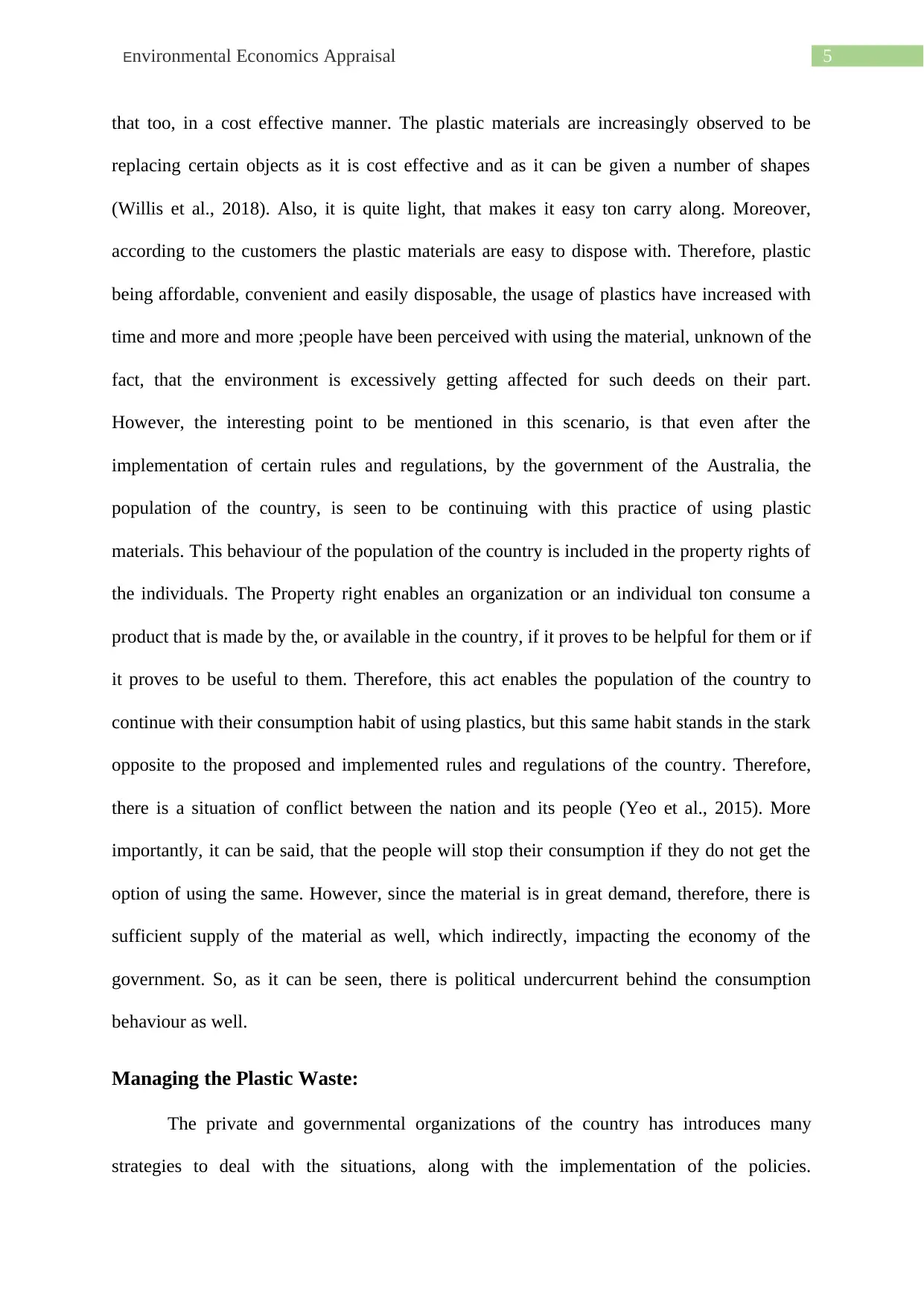
5Environmental Economics Appraisal
that too, in a cost effective manner. The plastic materials are increasingly observed to be
replacing certain objects as it is cost effective and as it can be given a number of shapes
(Willis et al., 2018). Also, it is quite light, that makes it easy ton carry along. Moreover,
according to the customers the plastic materials are easy to dispose with. Therefore, plastic
being affordable, convenient and easily disposable, the usage of plastics have increased with
time and more and more ;people have been perceived with using the material, unknown of the
fact, that the environment is excessively getting affected for such deeds on their part.
However, the interesting point to be mentioned in this scenario, is that even after the
implementation of certain rules and regulations, by the government of the Australia, the
population of the country, is seen to be continuing with this practice of using plastic
materials. This behaviour of the population of the country is included in the property rights of
the individuals. The Property right enables an organization or an individual ton consume a
product that is made by the, or available in the country, if it proves to be helpful for them or if
it proves to be useful to them. Therefore, this act enables the population of the country to
continue with their consumption habit of using plastics, but this same habit stands in the stark
opposite to the proposed and implemented rules and regulations of the country. Therefore,
there is a situation of conflict between the nation and its people (Yeo et al., 2015). More
importantly, it can be said, that the people will stop their consumption if they do not get the
option of using the same. However, since the material is in great demand, therefore, there is
sufficient supply of the material as well, which indirectly, impacting the economy of the
government. So, as it can be seen, there is political undercurrent behind the consumption
behaviour as well.
Managing the Plastic Waste:
The private and governmental organizations of the country has introduces many
strategies to deal with the situations, along with the implementation of the policies.
that too, in a cost effective manner. The plastic materials are increasingly observed to be
replacing certain objects as it is cost effective and as it can be given a number of shapes
(Willis et al., 2018). Also, it is quite light, that makes it easy ton carry along. Moreover,
according to the customers the plastic materials are easy to dispose with. Therefore, plastic
being affordable, convenient and easily disposable, the usage of plastics have increased with
time and more and more ;people have been perceived with using the material, unknown of the
fact, that the environment is excessively getting affected for such deeds on their part.
However, the interesting point to be mentioned in this scenario, is that even after the
implementation of certain rules and regulations, by the government of the Australia, the
population of the country, is seen to be continuing with this practice of using plastic
materials. This behaviour of the population of the country is included in the property rights of
the individuals. The Property right enables an organization or an individual ton consume a
product that is made by the, or available in the country, if it proves to be helpful for them or if
it proves to be useful to them. Therefore, this act enables the population of the country to
continue with their consumption habit of using plastics, but this same habit stands in the stark
opposite to the proposed and implemented rules and regulations of the country. Therefore,
there is a situation of conflict between the nation and its people (Yeo et al., 2015). More
importantly, it can be said, that the people will stop their consumption if they do not get the
option of using the same. However, since the material is in great demand, therefore, there is
sufficient supply of the material as well, which indirectly, impacting the economy of the
government. So, as it can be seen, there is political undercurrent behind the consumption
behaviour as well.
Managing the Plastic Waste:
The private and governmental organizations of the country has introduces many
strategies to deal with the situations, along with the implementation of the policies.
⊘ This is a preview!⊘
Do you want full access?
Subscribe today to unlock all pages.

Trusted by 1+ million students worldwide
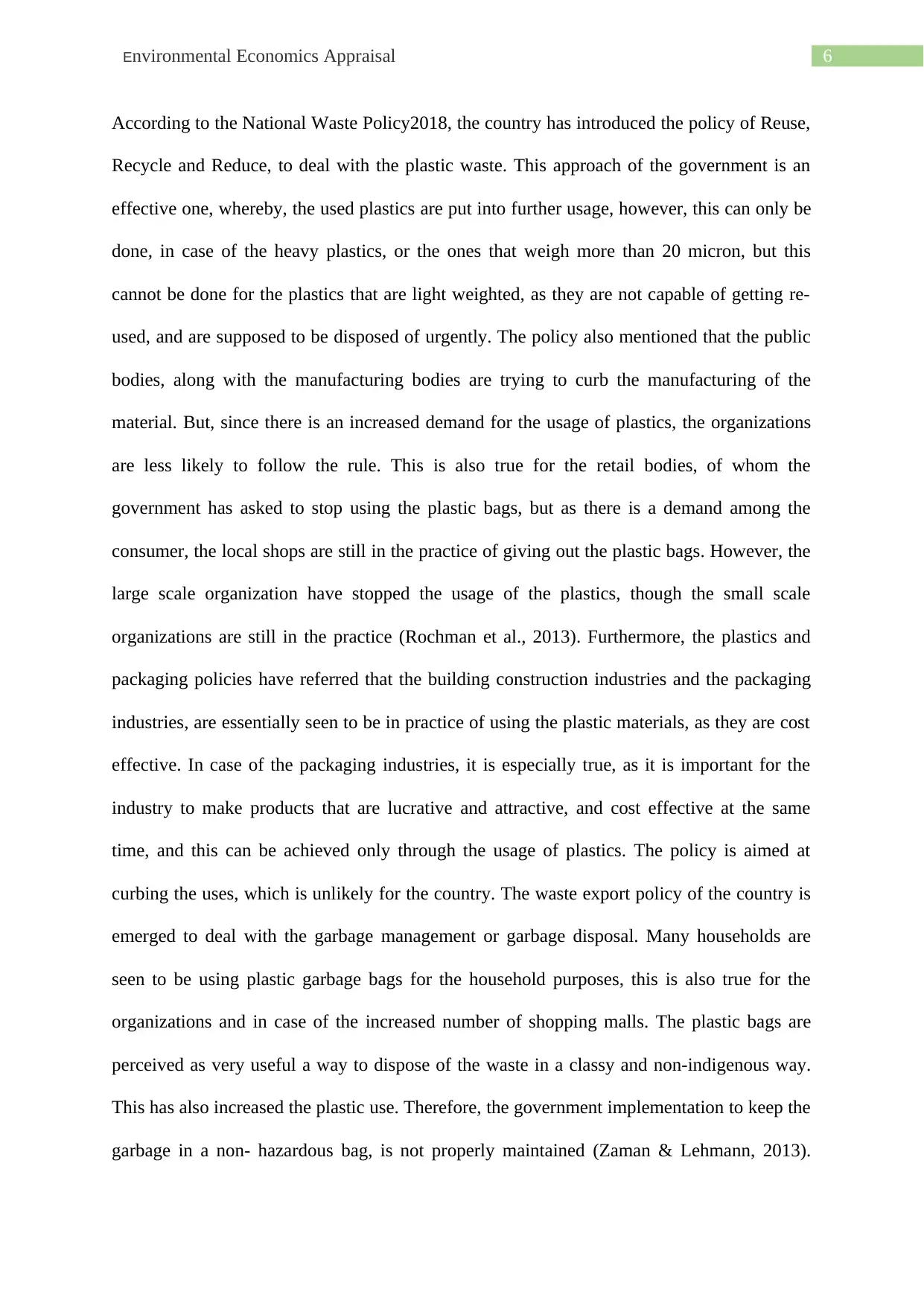
6Environmental Economics Appraisal
According to the National Waste Policy2018, the country has introduced the policy of Reuse,
Recycle and Reduce, to deal with the plastic waste. This approach of the government is an
effective one, whereby, the used plastics are put into further usage, however, this can only be
done, in case of the heavy plastics, or the ones that weigh more than 20 micron, but this
cannot be done for the plastics that are light weighted, as they are not capable of getting re-
used, and are supposed to be disposed of urgently. The policy also mentioned that the public
bodies, along with the manufacturing bodies are trying to curb the manufacturing of the
material. But, since there is an increased demand for the usage of plastics, the organizations
are less likely to follow the rule. This is also true for the retail bodies, of whom the
government has asked to stop using the plastic bags, but as there is a demand among the
consumer, the local shops are still in the practice of giving out the plastic bags. However, the
large scale organization have stopped the usage of the plastics, though the small scale
organizations are still in the practice (Rochman et al., 2013). Furthermore, the plastics and
packaging policies have referred that the building construction industries and the packaging
industries, are essentially seen to be in practice of using the plastic materials, as they are cost
effective. In case of the packaging industries, it is especially true, as it is important for the
industry to make products that are lucrative and attractive, and cost effective at the same
time, and this can be achieved only through the usage of plastics. The policy is aimed at
curbing the uses, which is unlikely for the country. The waste export policy of the country is
emerged to deal with the garbage management or garbage disposal. Many households are
seen to be using plastic garbage bags for the household purposes, this is also true for the
organizations and in case of the increased number of shopping malls. The plastic bags are
perceived as very useful a way to dispose of the waste in a classy and non-indigenous way.
This has also increased the plastic use. Therefore, the government implementation to keep the
garbage in a non- hazardous bag, is not properly maintained (Zaman & Lehmann, 2013).
According to the National Waste Policy2018, the country has introduced the policy of Reuse,
Recycle and Reduce, to deal with the plastic waste. This approach of the government is an
effective one, whereby, the used plastics are put into further usage, however, this can only be
done, in case of the heavy plastics, or the ones that weigh more than 20 micron, but this
cannot be done for the plastics that are light weighted, as they are not capable of getting re-
used, and are supposed to be disposed of urgently. The policy also mentioned that the public
bodies, along with the manufacturing bodies are trying to curb the manufacturing of the
material. But, since there is an increased demand for the usage of plastics, the organizations
are less likely to follow the rule. This is also true for the retail bodies, of whom the
government has asked to stop using the plastic bags, but as there is a demand among the
consumer, the local shops are still in the practice of giving out the plastic bags. However, the
large scale organization have stopped the usage of the plastics, though the small scale
organizations are still in the practice (Rochman et al., 2013). Furthermore, the plastics and
packaging policies have referred that the building construction industries and the packaging
industries, are essentially seen to be in practice of using the plastic materials, as they are cost
effective. In case of the packaging industries, it is especially true, as it is important for the
industry to make products that are lucrative and attractive, and cost effective at the same
time, and this can be achieved only through the usage of plastics. The policy is aimed at
curbing the uses, which is unlikely for the country. The waste export policy of the country is
emerged to deal with the garbage management or garbage disposal. Many households are
seen to be using plastic garbage bags for the household purposes, this is also true for the
organizations and in case of the increased number of shopping malls. The plastic bags are
perceived as very useful a way to dispose of the waste in a classy and non-indigenous way.
This has also increased the plastic use. Therefore, the government implementation to keep the
garbage in a non- hazardous bag, is not properly maintained (Zaman & Lehmann, 2013).
Paraphrase This Document
Need a fresh take? Get an instant paraphrase of this document with our AI Paraphraser

7Environmental Economics Appraisal
Further as mentioned in the national Waste Report, the recycling and reusing of the plastics
are essential however it is also perceived that the , high levels of recycling, as with reduction
in use, reuse and repair or re- manufacturing can allow for a given level of product service
with lower material inputs, which would otherwise be required (Laurent et al., 2014).
Recommendations:
To address the situation, the government can include the following recommendations.
The government must take effective measures to address the situations, and
implement the policies for the banning of using plastic effectively.
The small scale organizations and the packaging industries must be helped with,
coming up with newer ways to manage their products.
Similar measure must be taken for the local shops.
The government must employ its Research and Development team to come up with
newer products to fulfil the gap, as, until and unless there are products that can are a
perfect replacement of the product, the ban will not be successful.
Therefore, as a concluding point, it can be said that the government should focus upon
the policies more inclusively and holistically.
Further as mentioned in the national Waste Report, the recycling and reusing of the plastics
are essential however it is also perceived that the , high levels of recycling, as with reduction
in use, reuse and repair or re- manufacturing can allow for a given level of product service
with lower material inputs, which would otherwise be required (Laurent et al., 2014).
Recommendations:
To address the situation, the government can include the following recommendations.
The government must take effective measures to address the situations, and
implement the policies for the banning of using plastic effectively.
The small scale organizations and the packaging industries must be helped with,
coming up with newer ways to manage their products.
Similar measure must be taken for the local shops.
The government must employ its Research and Development team to come up with
newer products to fulfil the gap, as, until and unless there are products that can are a
perfect replacement of the product, the ban will not be successful.
Therefore, as a concluding point, it can be said that the government should focus upon
the policies more inclusively and holistically.

8Environmental Economics Appraisal
References:
Baral, H., Keenan, R. J., Fox, J. C., Stork, N. E., & Kasel, S. (2013). Spatial assessment of
ecosystem goods and services in complex production landscapes: A case study from
south-eastern Australia. Ecological Complexity, 13, 35-45.
Bilgili, F., Kocak, E., & Bulut, Ü. (2016). The dynamic impact of renewable energy
consumption on CO2 emissions: a revisited Environmental Kuznets Curve
approach. Renewable and Sustainable Energy Reviews, 54, 838-845.
Butler, J. R., Wong, G. Y., Metcalfe, D. J., Honzák, M., Pert, P. L., Rao, N., ... & Brodie, J.
E. (2013). An analysis of trade-offs between multiple ecosystem services and
stakeholders linked to land use and water quality management in the Great Barrier
Reef, Australia. Agriculture, Ecosystems & Environment, 180, 176-191.
Cappello, T., Mauceri, A., Corsaro, C., Maisano, M., Parrino, V., Paro, G. L., ... & Fasulo, S.
(2013). Impact of environmental pollution on caged mussels Mytilus galloprovincialis
using NMR-based metabolomics. Marine pollution bulletin, 77(1-2), 132-139.
Gouldson, A. and Murphy, J., 2013. Regulatory realities: The implementation and impact of
industrial environmental regulation. Routledge.
Laurent, A., Bakas, I., Clavreul, J., Bernstad, A., Niero, M., Gentil, E., ... & Christensen, T.
H. (2014). Review of LCA studies of solid waste management systems–Part I:
Lessons learned and perspectives. Waste management, 34(3), 573-588.
References:
Baral, H., Keenan, R. J., Fox, J. C., Stork, N. E., & Kasel, S. (2013). Spatial assessment of
ecosystem goods and services in complex production landscapes: A case study from
south-eastern Australia. Ecological Complexity, 13, 35-45.
Bilgili, F., Kocak, E., & Bulut, Ü. (2016). The dynamic impact of renewable energy
consumption on CO2 emissions: a revisited Environmental Kuznets Curve
approach. Renewable and Sustainable Energy Reviews, 54, 838-845.
Butler, J. R., Wong, G. Y., Metcalfe, D. J., Honzák, M., Pert, P. L., Rao, N., ... & Brodie, J.
E. (2013). An analysis of trade-offs between multiple ecosystem services and
stakeholders linked to land use and water quality management in the Great Barrier
Reef, Australia. Agriculture, Ecosystems & Environment, 180, 176-191.
Cappello, T., Mauceri, A., Corsaro, C., Maisano, M., Parrino, V., Paro, G. L., ... & Fasulo, S.
(2013). Impact of environmental pollution on caged mussels Mytilus galloprovincialis
using NMR-based metabolomics. Marine pollution bulletin, 77(1-2), 132-139.
Gouldson, A. and Murphy, J., 2013. Regulatory realities: The implementation and impact of
industrial environmental regulation. Routledge.
Laurent, A., Bakas, I., Clavreul, J., Bernstad, A., Niero, M., Gentil, E., ... & Christensen, T.
H. (2014). Review of LCA studies of solid waste management systems–Part I:
Lessons learned and perspectives. Waste management, 34(3), 573-588.
⊘ This is a preview!⊘
Do you want full access?
Subscribe today to unlock all pages.

Trusted by 1+ million students worldwide
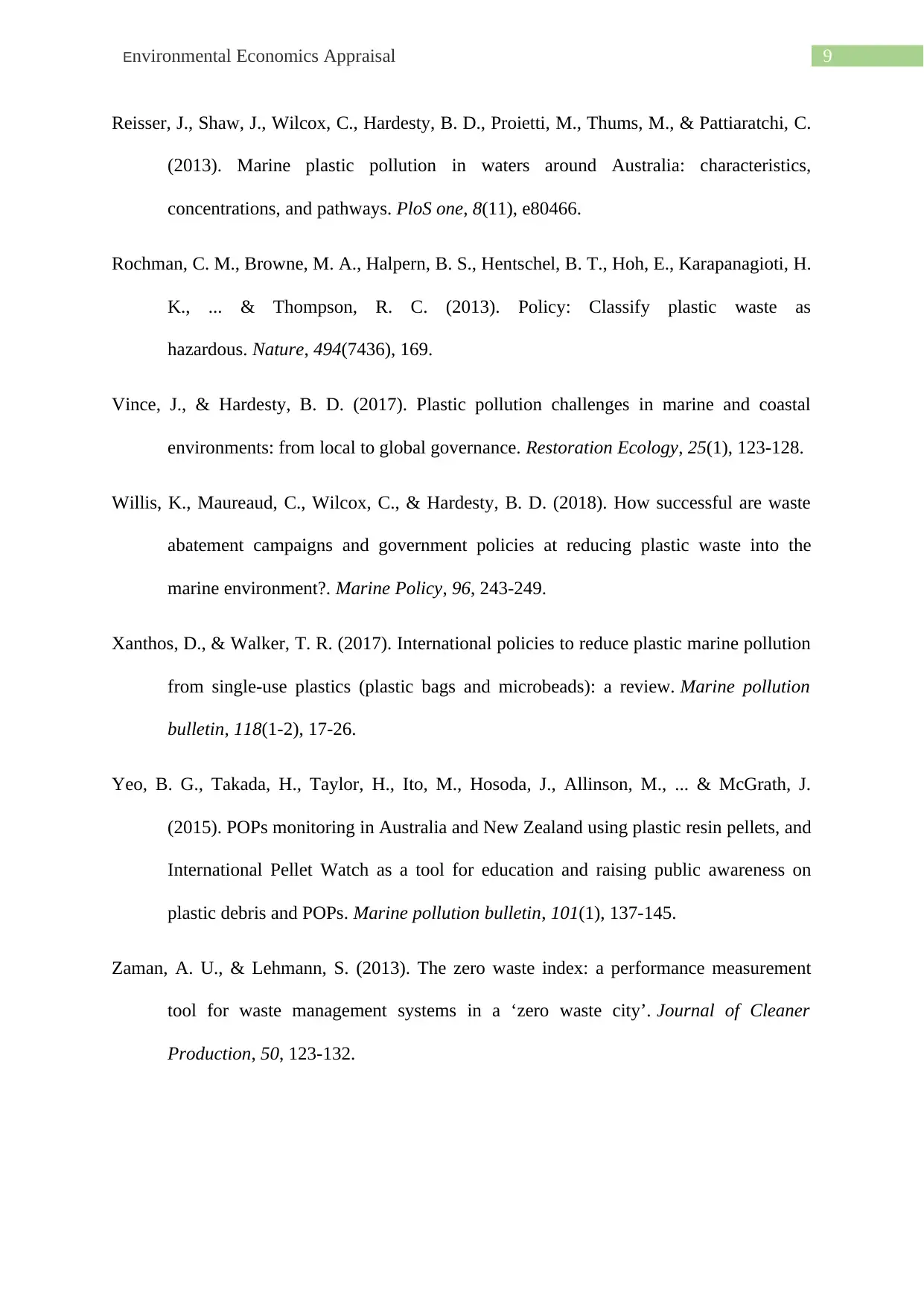
9Environmental Economics Appraisal
Reisser, J., Shaw, J., Wilcox, C., Hardesty, B. D., Proietti, M., Thums, M., & Pattiaratchi, C.
(2013). Marine plastic pollution in waters around Australia: characteristics,
concentrations, and pathways. PloS one, 8(11), e80466.
Rochman, C. M., Browne, M. A., Halpern, B. S., Hentschel, B. T., Hoh, E., Karapanagioti, H.
K., ... & Thompson, R. C. (2013). Policy: Classify plastic waste as
hazardous. Nature, 494(7436), 169.
Vince, J., & Hardesty, B. D. (2017). Plastic pollution challenges in marine and coastal
environments: from local to global governance. Restoration Ecology, 25(1), 123-128.
Willis, K., Maureaud, C., Wilcox, C., & Hardesty, B. D. (2018). How successful are waste
abatement campaigns and government policies at reducing plastic waste into the
marine environment?. Marine Policy, 96, 243-249.
Xanthos, D., & Walker, T. R. (2017). International policies to reduce plastic marine pollution
from single-use plastics (plastic bags and microbeads): a review. Marine pollution
bulletin, 118(1-2), 17-26.
Yeo, B. G., Takada, H., Taylor, H., Ito, M., Hosoda, J., Allinson, M., ... & McGrath, J.
(2015). POPs monitoring in Australia and New Zealand using plastic resin pellets, and
International Pellet Watch as a tool for education and raising public awareness on
plastic debris and POPs. Marine pollution bulletin, 101(1), 137-145.
Zaman, A. U., & Lehmann, S. (2013). The zero waste index: a performance measurement
tool for waste management systems in a ‘zero waste city’. Journal of Cleaner
Production, 50, 123-132.
Reisser, J., Shaw, J., Wilcox, C., Hardesty, B. D., Proietti, M., Thums, M., & Pattiaratchi, C.
(2013). Marine plastic pollution in waters around Australia: characteristics,
concentrations, and pathways. PloS one, 8(11), e80466.
Rochman, C. M., Browne, M. A., Halpern, B. S., Hentschel, B. T., Hoh, E., Karapanagioti, H.
K., ... & Thompson, R. C. (2013). Policy: Classify plastic waste as
hazardous. Nature, 494(7436), 169.
Vince, J., & Hardesty, B. D. (2017). Plastic pollution challenges in marine and coastal
environments: from local to global governance. Restoration Ecology, 25(1), 123-128.
Willis, K., Maureaud, C., Wilcox, C., & Hardesty, B. D. (2018). How successful are waste
abatement campaigns and government policies at reducing plastic waste into the
marine environment?. Marine Policy, 96, 243-249.
Xanthos, D., & Walker, T. R. (2017). International policies to reduce plastic marine pollution
from single-use plastics (plastic bags and microbeads): a review. Marine pollution
bulletin, 118(1-2), 17-26.
Yeo, B. G., Takada, H., Taylor, H., Ito, M., Hosoda, J., Allinson, M., ... & McGrath, J.
(2015). POPs monitoring in Australia and New Zealand using plastic resin pellets, and
International Pellet Watch as a tool for education and raising public awareness on
plastic debris and POPs. Marine pollution bulletin, 101(1), 137-145.
Zaman, A. U., & Lehmann, S. (2013). The zero waste index: a performance measurement
tool for waste management systems in a ‘zero waste city’. Journal of Cleaner
Production, 50, 123-132.
1 out of 10
Your All-in-One AI-Powered Toolkit for Academic Success.
+13062052269
info@desklib.com
Available 24*7 on WhatsApp / Email
![[object Object]](/_next/static/media/star-bottom.7253800d.svg)
Unlock your academic potential
Copyright © 2020–2025 A2Z Services. All Rights Reserved. Developed and managed by ZUCOL.
